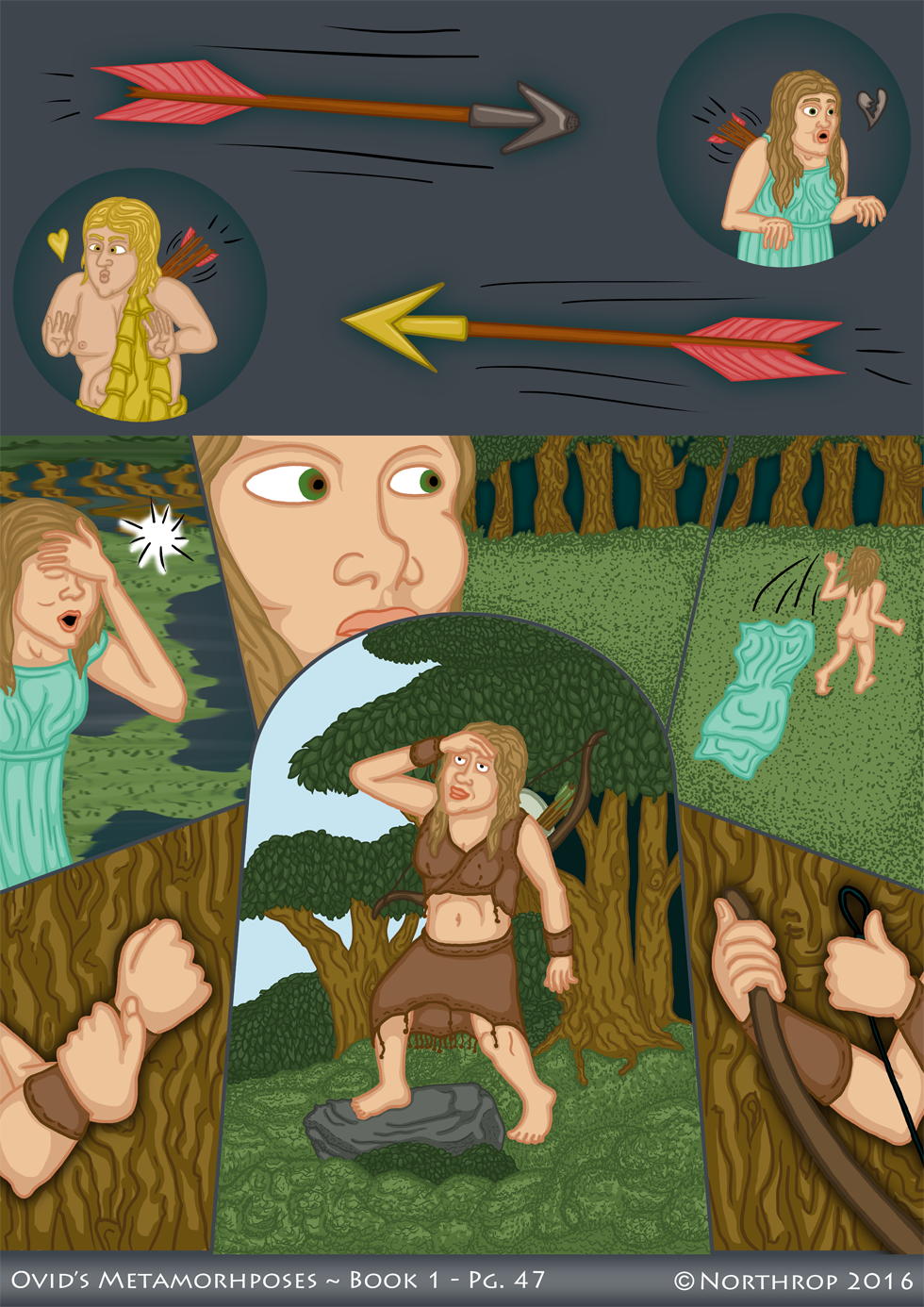Met. 1.472-7 – Cupid’s Arrows Hit Their Marks
hoc deus in nympha Peneide fixit, at illo
laesit Apollineas traiecta per ossa medullas.
Protinus alter amat, fugit altera nomen amantis,
silvarum latebris captivarumque ferarum
exuviis gaudens innuptaeque aemula Phoebes.
[vitta coercebat positos sine lege capillos.]
(Met. 1.472-7
This one [i.e. the lead arrow] the god [Cupid] pins in Peneus’ daughter-nymph [Daphne], while with the other
he wounds Apollo down to the marrow in his bones.
He falls head over heels in love, she flees even the word “lover”,
rejoicing in the skins of woodland beasts snared in their hiding places
and emulating unmarried Phoebe [Diana/Artemis].
[a headband held her uncombed hair.]
CORRECTION (22 September, 2016): I changed the translation slightely to render it more faithful to the Latin. The word “exuviis” can mean clothing/armour, but is equally likely to be “spoils” or “skins”. Nevertheless, I do not regret dressing Daphne in leather, because those skins have to go somewhere, right?
Sorry for the delay in the update, y’all – I actually have had this page done for a few days, but didn’t have time post until now. The PhD is steaming ahead. I hope to finish up work on the main chapters by around the end of October. From there, it’s just editing and other stuff before submission in December. Thanks for bearing with me through all this; your patience will be rewarded with more frequent updates in the New Year!
I had a little fight with myself over how to do this page. In these lines, there is a complex series of actions, which are not necessarily visibile. Depicting these actions is tricky, as is decided whether to include Ovid’s narration I first decided against narration, because I want the actions of the narrative episodes to speak for themselves as much as possible. Next, I decided to have the arrows flying and striking their targets set against a grey background, almost as if the action is taking place in some pocket dimension. We then get a fade into reality and Daphne, who throws aside her peplos, a garment associated with young girls on the cusp of marriage. She runs into the woods and kits herself out as we will see her throughout this episode: in homemade leather clothes, with a bow and arrow. Ovid never explicitly mentions her carrying a bow. Nevertheless, her skill as an archer is emphasised in Parthenius, Erotika Pathemata 15, which is the oldest direct account of the Daphne story (it only predates Ovid by a generation, though). She is connected to Artemis-Diana, an archer goddess and a character we haven’t properly met yet (you can see her with the other gods, next to Apollo, on page 21). However, whereas she was Diana’s protege in Parthenius, she “emulates” (“aemula”, Met. 1.476) Diana in Ovid. This word, aemula, is a loaded one in Latin poetry – it implies imitation, but an imitation that rivals or challenges. Poets would be accused of “emulating” older ones, which was a euphemism for calling them either rip-off artists or self-important hacks. Therefore, there is something rather hubristic about the way Daphne emulates Diana. I’ll have more to say on this in the coming pages (I don’t want to give spoilers yet), but for now, keep an eye on Daphne and what it is she wants out of her life (also remember that she is a deity herself, albeit a minor one).
You’ll notice that I didn’t give her a hairband, like line 477 says. This line is bracketed in Tarrant’s edition, meaning it is probably added later and not part of Ovid’s poem. I have decided to judge each bracketed section on its own merits, and will sometimes illustrate them, sometimes not (but I will always include them in the text below the comic). In this case, the line seems to contradict a description of Daphne at Met. 1.497, where her hair is unadorned. Therefore, I decided to leave off the headband. Was I right? Do you think line 477 is actually contradicted by 497? Let me know in the comments!

Discussion ¬